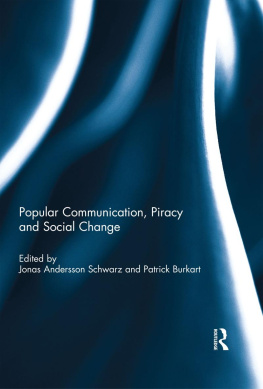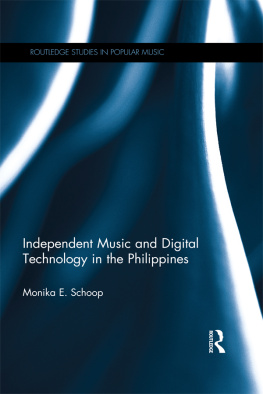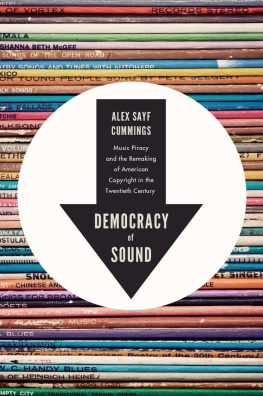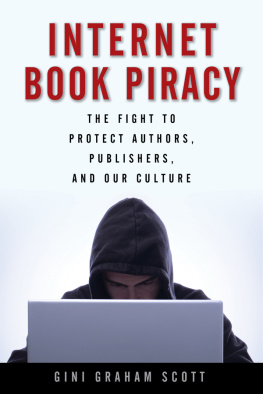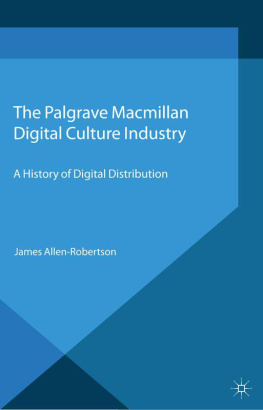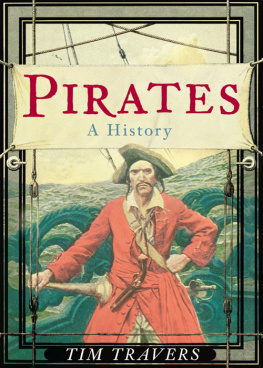The Piracy Crusade
A volume in the series
Science/Technology/Culture
Edited by
Carolyn de la Pea
Siva Vaidhyanathan
The Piracy Crusade
How the Music Industrys War on Sharing Destroys Markets and Erodes Civil Liberties
Aram Sinnreich
University of Massachusetts Press
AMHERST AND BOSTON
Copyright 2013 by Aram Sinnreich
License: This entire work (with the exception of photographic illustrations by third parties) is released under the terms of a Creative Commons Attribution-NonCommercial-ShareAlike 3.0 United States license (https://creativecommons.org/licenses/by-nc-sa/3.0/us/). Some Rights Reserved.

Printed in the United States of America
ISBN 978-1-62534-62534-052-8 (paper); 051-1 (hardcover)
Designed by Dennis Anderson
Set in Dante by House of Equations, Inc.
Printed and bound by IBT/Hamilton, Inc.
Library of Congress Cataloging-in-Publication Data
Sinnreich, Aram, author.
The piracy crusade : how the music industrys war on sharing destroys markets and erodes civil liberties / Aram Sinnreich.
pages cm. (Science/technology/culture)
Includes bibliographical references and index.
ISBN 978-1-62534-052-8 (pbk. : alk. paper)
ISBN 978-1-62534-051-1 (hardcover : alk. paper)
1. CopyrightMusic. 2. Piracy (Copyright)Prevention. 3. Music tradeLaw and legislation. 4. Music and the Internet. 5. Sound recordingsPirated editions. 6. Civil rights. I. Title.
K1450.S56 2013
346.0482dc23
2013040189
British Library Cataloguing-in-Publication Data
A catalogue record for this book is available from the British Library.
This one goes out to Dunia.
The world of grownups is so corrupt! Can it be, can it be, can it be stopped? Ari Up
The most important thing is to realize that you can accomplish something. Aaron Swartz
CONTENTS
ACKNOWLEDGMENTS
L IKE ALL creative work, this book resulted from the contributions of a great many people and institutions. Although the genesis of my research on digital music and piracy dates back to my work at Jupiter Research at the turn of the century, my interest was rekindled when I served as an expert witness for the defense in Arista Records v. Lime Group in 201011. Several attorneys for the defendants, including John Oller, Joseph Baio, Tariq Mundiya, Todd Cosenza, and Chris Miritello, served as sounding boards for my expert report in the case, which is a distant ancestor to the book you are now reading.
As I wrote the book manuscript itself, I received copious help from several sources. I thank Kathleen Fitzpatrick and her colleagues at Media Commons Press for graciously allowing me to post my draft chapters for open review on their website. Seeing each section in print as soon as I had completed it, and knowing it was instantly available to the public sphere, gave me the fortitude to continue working on a project that would have been far more difficult to finish had I been consigned to the book authors standard vacuum. I am also thankful to my colleagues at Rutgers Universitys School of Communication and Information, and especially those within the Department of Journalism and Media Studies, for consistently supporting my work and affording me the resources to complete it.
A great many people read and commented on my draft manuscript, via both personal interactions and the MediaCommons website. The feedback was overwhelmingly positive and constructive, but I appreciated every comment, even those that were neither. Although some commenters have opted to stay anonymous, I can explicitly thank Jesse Lifshitz, Samantha Kretmar, Frank Bridges, Vicki Simon, Peter Axelrad, Billy Pidgeon, Richard M. Stallman, Mark Mulligan, John McCartney, Cory Doctorow, Vivien Goldman, Norman Savage, Marissa Gluck, Nicole Lewis, Eric Steuer, Ray Beckerman, Fred von Lohmann, Lucas Gonze, Joost Smiers, Bryce Renninger, Judah Phillips, Josh Chasin, Evan Korth, Joly MacFie, Tom Hughes, Mark Oltarsh, David Ritz, Michael Carrier, Mark Latonero, Kathryn Tasker, Parker Higgins, Karl Fogel, Alissa Quart, Peter Maass, Mike Brown, Camille Reyes, Daniel Timianko, Ben Kallos, Robert Schultz, Todd Nocera, danah boyd, Jesse Gilbert, Larry Gross, Barbara Reed, Susan Keith, Nancy Zager, Masha Zager, Jonathan Sinnreich, and the late Tom Barger for their feedback and encouragement.
I also owe a great debt to those more instrumentally involved in the development of this book, including all of my interviewees and primary sources, my extremely thorough and supportive no-longer-anonymous peer reviewers, Nancy Baym and Patricia Aufderheide, my patient and overtasked friend Nathan Graham, who whipped the manuscript into submission shape, the brilliant Josh Neufeld, who graciously agreed to create cover art on a tight budget and an open license, and the folks at University of Massachusetts Press, specifically my series editors, Siva Vaidhyanathan and Carolyn de la Pea, as well as Bruce Wilcox and Clark Dougan, who have been willing to go out on more than a few limbs on my behalf.
Finally, I thank four generations of my family for continuing love and support, especially my wife, muse, and bandleader Dunia Best Sinnreich, without whose unwavering faith and patience I could never have written a word of this book.
Each of you is reflected in these pages. I hope you like what you see.
Introduction
Piracy Crusades Old and New
The fight by creative industries against digital piracy is an economic necessity, not a moral crusade.
International Federation of the Phonographic Industry (IFPI), Digital Music Report 2011
A business model built on infringement is not only morally wrong but legally wrong.
Hilary Rosen, CEO, Recording Industry Association of America (RIAA), 2001.
Im on a little crusade, and I do have personal interaction with these students.... I think these young kids are going to understand that it is not only morally wrong, theyre stealing.
Jack Valenti, president and CEO, Motion Picture Association of America (MPAA), 2003
We remain the national leader in the crusade against illegal copying and distribution of software and content online.... In 2010, we intend to be even more vigilant in our pursuit of software and content piracy.
Software & Information Industry Association, Anti-Piracy Year-In-Review 2009
I N 1390, an army of crusaders set out to wage war on piracy, with disastrous consequences for the soldiers themselves, their nations, and the entire Western world.
The story begins in Genoa, a coastal city located at the western hip of Italys boot, which was emerging as one of Europes wealthiest and most influential seats of power. Like its chief competitor, Venice (located at the boots eastern hip), the city had developed its wealth by dominating the trade of commodities with the Syrian and Egyptian infidels across the Mediterranean sea, despite a prohibition against such commerce handed down by the Pope.
Genoa had one problem that Venice lacked: in order to gain access to the eastern end of the Mediterranean, its sailors had to pass through the Strait of Sicily, a relatively narrow aperture separating Europe from the jutting shores of North Africa. For centuries, Tunisian privateers had policed these waters, and for centuries Genoese ships had done battle with them, raiding one another in countless skirmishes and a few full-scale assaults. Yet the Tunisian pirates were becoming bolder, thanks to the encouragement of the reigning sultan, Ahmad II ibn-Muhammad, who had begun to shift his European political allegiances from Italy to Catalonia.
Next page

